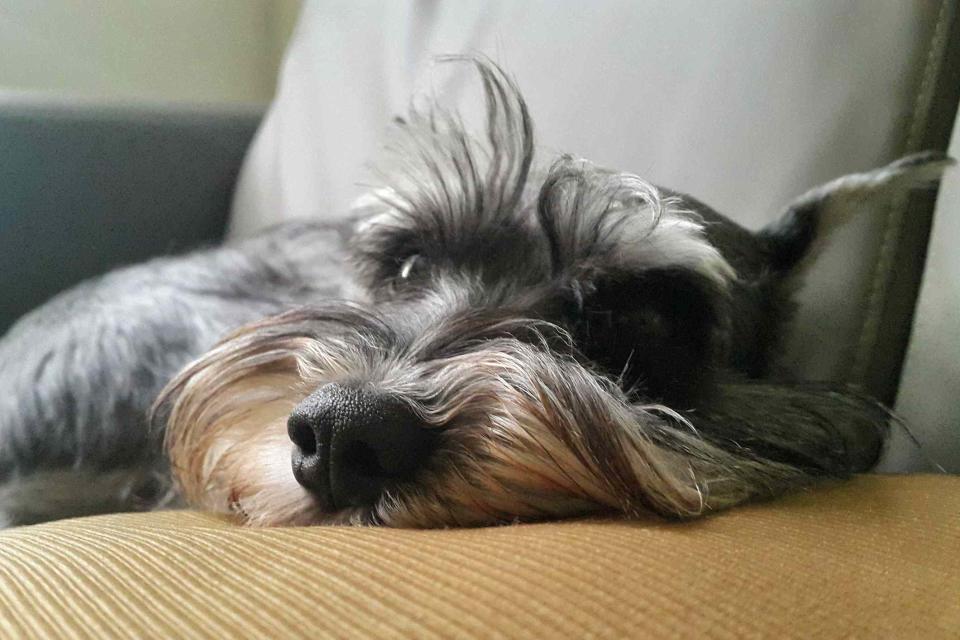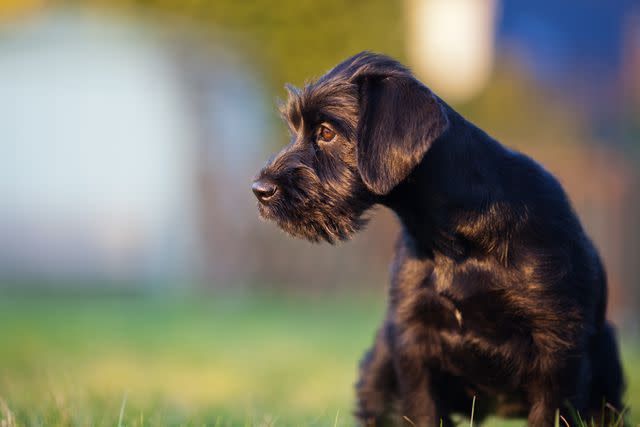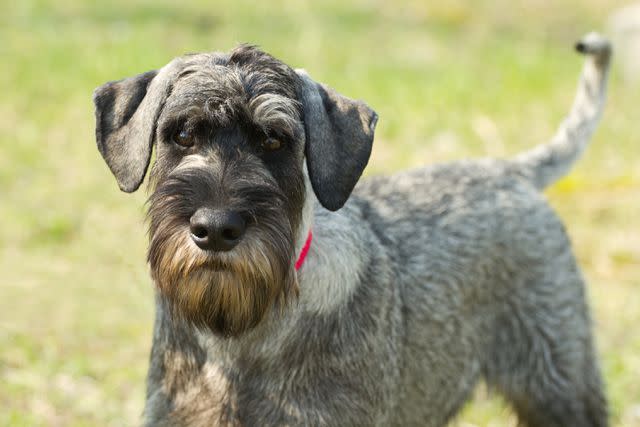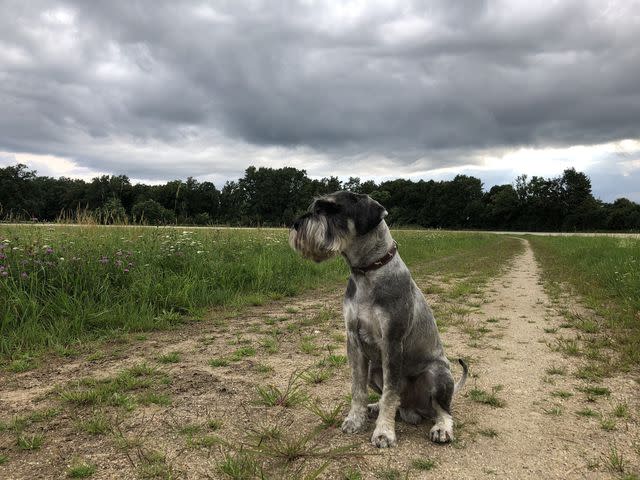Standard Schnauzer: Dog Breed Characteristics & Care
History, Care Tips, and Helpful Information for Pet Owners

Rolando Silva / EyeEm / Getty Images
The standard schnauzer is a medium-size hardworking farm dog from Germany, known for their trademark bristly eyebrows and beard. The intelligence and sociable nature possessed by these stately canines make them outstanding companions.
With two coat colors—solid black or salt and pepper—the schnauzer has a relatively uniform look. However, under that wiry and rumpled coat is a real character, with many people describing their dog as almost human-like in their antics and expressions.
Learn all about the standard schnauzer, from the dog’s history to their care needs and more.
Breed Overview
GROUP: Working
HEIGHT: 18 to 20 inches (male); 17 to 19 inches (female)
WEIGHT: 35 to 50 pounds (male); 30 to 45 pounds (female)
COAT: Double coat with wiry appearance
COAT COLOR: Black; salt and pepper
LIFE SPAN: 13 to 16 years
TEMPERAMENT: Intelligent, devoted, good-natured, lively, playful
HYPOALLERGENIC: Yes
ORIGIN: Germany
Characteristics of the Standard Schnauzer
The standard schnauzer is a warm and affectionate breed with plenty of energy and intelligence for any task. However, they are not a passive pet that you can just leave to their own devices. Be sure that you understand the nature and needs of a schnauzer before you bring one home.
Affection Level | High |
Friendliness | Medium |
Kid-Friendly | High |
Pet-Friendly | High |
Exercise Needs | Medium |
Playfulness | Medium |
Energy Level | Medium |
Trainability | High |
Intelligence | High |
Tendency to Bark | Medium |
Amount of Shedding | Low |
History of the Standard Schnauzer
The end of the Middle Ages saw the beginning of the bearded Bavarian farm dog—today known as the schnauzer. Originating in Germany sometime during the 15th century, these adaptable and hardworking dogs served as an indispensable part of farm life. Their medium size also made them ideal for taking goods to market. The breed was compact enough to sit in the wagon but wouldn’t hesitate to ward off thieves with a booming bark—and a bite if the intruder didn’t get the hint.
Back at home, schnauzers were tasked with hunting vermin and other small prey, guarding against intruders, and assisting in herding activities. As a result, these dogs developed a watchful attitude, a keen prey drive, and a steady disposition. Today, they retain the drive of a dog bred to work but also relish their role as a family companion.
Interestingly, the schnauzer was originally known as the wire-haired pinscher and considered to be the same breed as the dog we today know as the German pinscher. In the early 1900s, the wire-haired pinscher established its own identity as a distinct breed and left the pinscher name behind. The name "schnauzer" is taken from the German word for muzzle or snout—and with such a distinctive wiry beard, it’s not hard to see why this became the defining feature and moniker for the breed.
Around this time, breed enthusiasts introduced grey keeshonds and black poodles to solidify the coat colors carried in the genes of schnauzers today: salt and pepper, and black. As the schnauzer staked its place in the dog breed world, fanciers began breeding miniature and giant versions, although the medium size of the standard schnauzer is often described by people as just right for any activity.
The reliability of the schnauzer breed has been put to use in police work, bomb detection, and search and rescue work. During World War I and World War II, schnauzers assisted the troops and also worked with the Red Cross.
As early as 1904, the AKC recognized the schnauzer but the breed remained relatively rare in the United States. After World War I, schnauzers were imported to the United States with greater frequency than in the decades preceding the war.
In 1925, a breed club was created to represent the interests of the breed and serve as a protector and ambassador. It was known as the Schnauzer Club of America, which later divided into the Standard Schnauzer Club of America and a separate organization for miniature schnauzers—the American Miniature Schnauzer Club.
Standard Schnauzer Care
The schnauzer approaches life with a focused mentality and is ever alert. At the same time, this breed learns quickly and adapts readily. The schnauzer needs an outlet for their energy, but when properly exercised and engaged, the breed is neither characteristically hyperactive nor overly lethargic.
This companion dog should not be left to fend for themselves. They are very smart and sociable, so they crave interaction with their human companions. Plenty of exercise, frequent training sessions, and opportunities for play will tire both the mind and body of the schnauzer.
Exercise
A standard schnauzer will benefit from exercise that includes at least one long walk daily plus several shorter outings and play sessions that total about an hour a day.
Some schnauzer pet parents report that their dogs have excellent recall and never stray far off-leash, but use caution in deciding whether to let your schnauzer roam free. The safest course is to only let your dog off-leash in a fenced area.
Schnauzers make great jogging partners, will be up for a hike, and enjoy canine competitions like agility, rally, and obedience. Training for such events also allows the schnauzer to fulfill their need to work with you and for you.
These dogs also enjoy activities that let them use their snout for sniffing. Let them sniff during walks, play with puzzle toys, search for toys around the house, or participate in barn hunting, as a few examples.
At the same time, lots of schnauzer pet parents love that their dogs are always happy to curl up on the couch and spend time relaxing with them.
Grooming
The schnauzer’s characteristic double coat requires some TLC to keep it looking great. Regular brushing of the fur with a bristle brush, pin brush, slicker brush, and comb is important to keep mats from forming and to keep the eyebrows, beard, and leg feathering free of debris.
Many schnauzer pet parents lament how drippy and dirty the beard of a schnauzer can become from eating and drinking. Be sure to regularly wipe your schnauzer’s beard to help reduce odors and discoloration.
Schnauzers are non-shedding and are sometimes better tolerated by allergy sufferers. However, since the hair grows continuously, regular grooming is required to keep the coat in check. There are two ways to approach grooming schnauzer: hand stripping or clipping.
It may take some searching to find a groomer that can hand strip (pluck/remove dead hairs by hand) your schnauzer. However, purists of the breed recommend this over the more common clipper method of grooming.
Using clippers on a schnauzer’s coat gradually reduces the wiry top layer of fur and reduces the coat’s resistance to water and debris, along with changing the color and appearance. Hand stripping might be more expensive or difficult to find, but it should be noted that doing so leads to slower hair re-growth. You can expect up to five or six months in between hand stripping sessions versus the six to eight weeks between clipping sessions.
Tips
This breed needs to be groomed often. Get your standard schnauzer used to going to the groomer or being groomed at home from an early age. This includes getting them used to having their paws handled and being around scissors and clippers.
Training
Keep in mind that mental engagement is a critical part of the training and care for a standard schnauzer. As a working dog, the schnauzer thrives when they have a task to do.
Unlike many high-energy sporting breeds, it’s not just a matter of giving your schnauzer a good physical workout. These dogs also need to find fulfillment in using their intelligence and work ethic. If this is overlooked, they will find their own work to be done—which can include destructive behaviors or becoming too territorial over people and property.
However, schnauzers raised by responsible dog owners are known for having well-rounded and reliable personalities. They have an innate alertness and will be quick to sound the alarm over perceived intruders, but they are not generally known to be excessive barkers (especially when compared to the miniature schnauzer). They may regard newcomers with wariness, but will be put at ease when they see these guests warmly welcomed by the pack leader.
Balance is the important thing when training a schnauzer. If you include the right ratio of exercise, training, and mental stimulation, these dogs blossom into wonderful companions. Just be sure that you maintain your position as the pack leader since the intelligence of this breed can quickly lead to dominance or stubborn tendencies.
Tips
Teach your kids how to properly approach and touch your standard schnauzer. Also, supervise their interactions to ensure they don’t accidentally hurt each other.



Common Health Problems
The standard schnauzer has a few potential health concerns to be aware of, but in general this is a healthy breed that isn’t plagued with problems. These dogs can live up to be 13 to 16 years old (or more), which is a considerable life span for a medium-sized breed.
Here are the health problems occasionally faced by standard schnauzers:
Heart disease: Standard schnauzers are prone to dilated cardiomyopathy, a disease in which the heart can become large, thin, and weak.
Skin allergies: Many schnauzers suffer from sensitive skin, resulting in excessive licking and scratching.
Eye problems: Standard schnauzers can often suffer from dry eye, where the tear glands do not produce enough moisture. Extra hairs can also grow inside the eyelid of this breed.
Bladder and kidney stones: Bladder stones form in the bladder, while kidney stones develop in the kidneys. Symptoms include difficulty urinating and blood in the urine.
One thing that has improved the health of the breed has been screening for the typical health problems. A commitment to identifying problems and preventing future generations from inheriting certain health conditions has assisted in making the breed healthier.
Diet and Nutrition
Like any dog, schnauzers do best when fed a balanced diet of high-quality dog food. This breed tends to become overweight, so care should be taken not to overfeed or give too many treats. Obesity has the potential to cause diabetes, back and joint problems, and more adverse health consequences.
Where to Adopt or Buy a Standard Schnauzer
Expect to pay a breeder between $1,500 to $2,700 for a standard schnauzer puppy.
Adopting a schnauzer can be a great start to years of happy dog companionship. If you’re looking for a standard schnauzer, be sure to check with any shelters or rescue groups in your area. Regional and national rescue organizations have also been set up to help displaced schnauzers find a fresh start.
Your search for a standard schnauzer breeder may be more limited than if you were looking for a miniature schnauzer breeder. However, there are still plenty of breeders that are committed to the standard size of this breed. You should carefully research any breeder that you’re interested in and realize that you may have to join a waiting list for the perfect pup.
Begin your search through the following organizations:
Standard Schnauzer Overview
Standard schnauzers are great dogs who are devoted and intelligent. They have high grooming requirements and thrive when they have some type of work to do, but can be wonderful family dogs and loyal companions.
Pros of Standard Schnauzers
Affectionate with family members
Makes a good watchdog
Sheds very little
Cons of Standard Schnauzers
Requires plenty of mental engagement
Can become protective if not socialized well
Needs regular visits to the groomer
30 Medium-Size Dog Breeds for Your Lifestyle
More Dog Breeds and Further Research
If you are interested in the standard schnauzer as your next pet, you might also be intrigued with these similar dog breeds:
There’s a whole world of potential dog breeds out there—with a little research, you can find the right one to bring home!
Frequently Asked Questions
Are standard schnauzers good with kids?
Schnauzers make great family dogs. They tend to be very patient and protective with children, though it is important that children are taught how to properly interact with dogs from an early age. Some schnauzers are less than tolerant to bad handling from children, such as ear or tail pulling. So be sure that you supervise interactions between your schnauzer and kids, especially if the children are young or unfamiliar to your dog.
Do standard schnauzers bark a lot?
Standard schnauzers tend to bark when they want to alert you to something. They are not known for barking excessively.
What are the personality differences between a miniature, standard, and a giant schnauzer?
The miniature schnauzer may be a bit more affectionate towards their humans and less aggressive than the other two more independent sizes. Interestingly, the AKC puts the mini as part of the terrier group and the other two sizes of schnauzers in the working dog group.
Read the original article on The Spruce Pets.